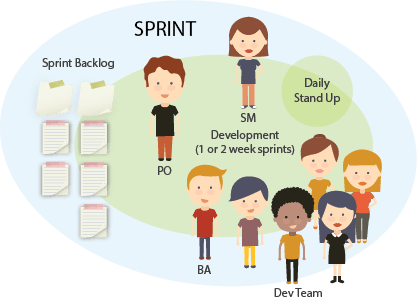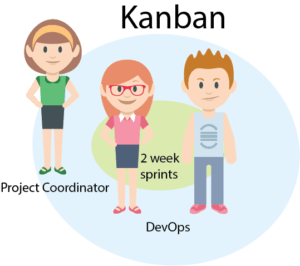Adopt and Adapting Agile
I aim to use 2 examples that demonstrate how you can deliver “projects” (both Software and more complex work) for customers (in this case Product Managers) using single and multiple teams but still remain largely Agile in the methodologies each team utilises.
Need Your IT Teams and Product Teams Working Together: How ITSM and Agile can Work Together.
There are some great readings about adapting Agile: Tips to Adapt Agile Product Management to Your Team’s Processes.
Problem: I want to deliver an “On-line E-commerce Platform” for a Product Owner involving multiple teams, whilst enabling the delivery teams to use the tools and Agile methodologies they are familiar with to deliver the agreed outcomes for the Product Owner.
Tools used: Jira
Methodologies used: Agile: Kanban and Scrums with Sprints
Delivering an “On-line E-commerce Platform” using one Software Scrum team
Picture this you have a Product Manager (your “customer” in this example)

and there is a Scrum Team that works with the Product Owner to develop their “On-line E-commerce Platform”.

The Software Scrum team runs 2-week Sprints to deliver outcomes as agreed between the Product Owner and the Scrum Team. All sprint tasks are added to Jira so that there is a clear way for the Product Manager to understand the status of each task as the Software Scrum team ensures their assigned tasks are updated.

After the 2 week sprint the Scrum team, along with the Product Owner will hold a retrospective on the previous Sprint (what went well, what was delivered, lessons learnt etc)

Delivering an “On-line E-commerce Platform” using multiple teams
So what happens when you need to involve multiple teams to deliver the “On-line E-commerce Platform” for the Product Manager? Would you use the same process? Who is going to organise the delivery sequence and inter-dependencies, the Scrum Master? Do you need a Project Manager? What about your environment builds, integrating into your billing platform?
So what to do?
A Project Coordinator or Project Manager (depending on the scale and number of teams involved) is assigned as the central point of contact for the coordination of tasks between the various teams and 3rd parties, they will also attend the daily stand-ups.

This way of Agile working also enables the multiple teams to run their own methodologies to deliver the desired outcome for the Product Manager. In this case, the DevOps and Billing teams utilise a Kanban approach to ensure all tasks are added to their backlog or current 2-week Sprint in Jira and delivery time frames align with the Software Scrum team’s 2-week Sprint (as per example 1). Inter-dependencies are also managed by the Project Coordinator so that the DevOps teams complete their tasks (ideally in previous Sprints) before the Software Teams can start their tasks, you don’t want to become a blocker!!!



A bit of the old-world PMO thrown in
To enable capitalisation on the work required to deliver the “Online E-commerce Platform” time spent on each task is recorded in Jira and reported monthly by the Project Manager/Coordinator.
To ensure senior management has a view on work undertaken by the group the “Online E-commerce Platform project” is added to the portfolio plan with start and finish dates, Opex and Capex assigned, along with any other information required.
Adopting and Adapting
By adopting this flexible yet coordinated approach, you can leverage the strengths of various Agile project methodologies while delivering a cohesive e-commerce platform. This strategy respects team preferences, maintains overall project alignment, and allows for adaptive responses to evolving product requirements.

